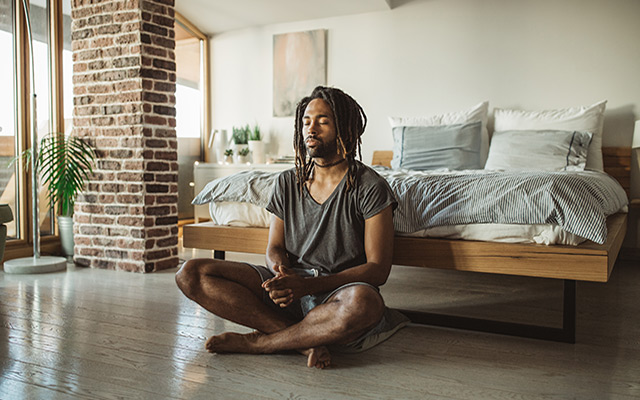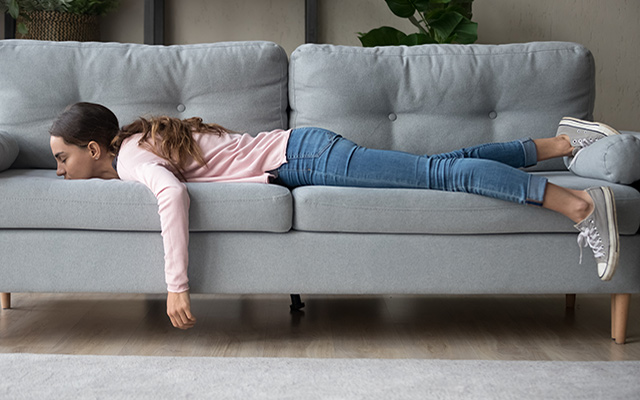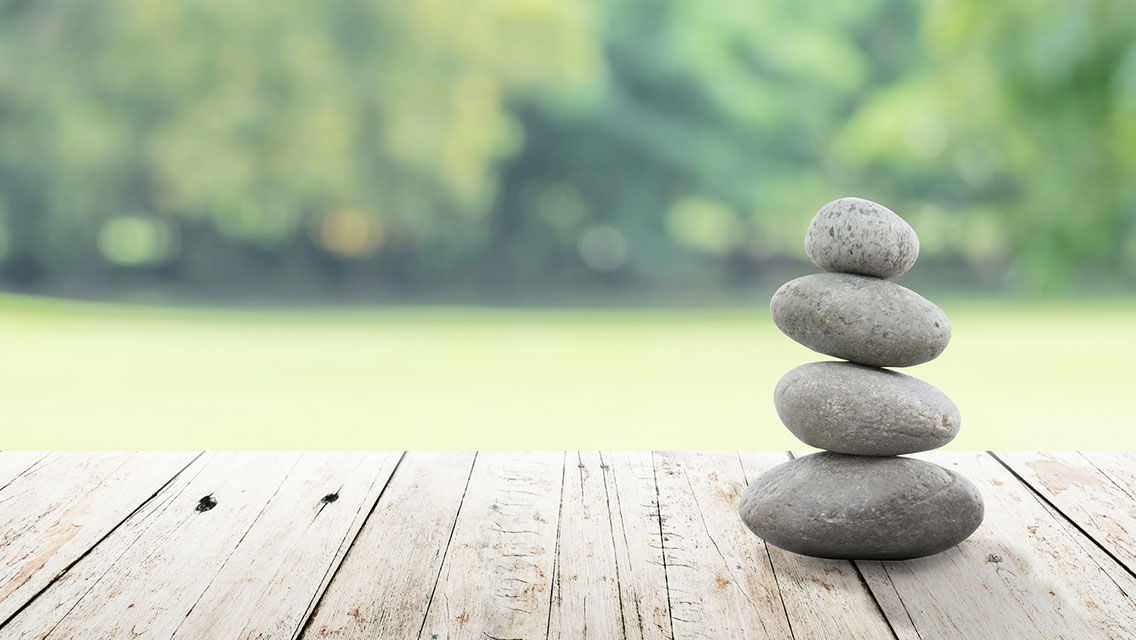ARTICLE SHORTCUTS
Take a Breath | Try Some Stillness | Get Moving | Clear the Clutter | Do Just One Thing
It’s been a stressful year. The triggers are everywhere: We’re worried about our health, our loved ones, our jobs, our finances, our futures. Front-line workers are putting their lives at risk while coping with fear, anxiety, and exhaustion. If we’re lucky, we’ve been working from home, perhaps wedging video meetings in between making breakfast and tending to the kids. As stay-at-home orders continue to loosen, we’re trying to come to terms with our own risk tolerance while guessing at the rules that will govern our new normal. All of us are wrestling with collective grief and fear of the unknown.
Truthfully, many of us were operating in a state of chronic stress before the coronavirus pandemic, according to Aviva Romm, MD, integrative physician and author of The Adrenal Thyroid Revolution. “Before the start of 2020, we were already experiencing an all-time high for burnout and depression, particularly among healthcare workers,” Romm says. “We know that, more than ever, people are struggling with sleep problems and anxiety.”
The body’s stress response is ideal for handling short-term threats by triggering fight-or-flight, a survival mechanism that enables us to react quickly when our lives are in danger. But certain aspects of our modern lives — like constantly pinging smartphones and always-on work cultures — mean that many of us are stuck in a chronic state of stress activation known as “allostatic load.” (For more on how to shift from fight-or-flight into a calmer state, see “Reset Your Stress.”)
“Allostasis refers to normal stressors and our ability to be resilient in the face of them,” Romm explains. “Allostatic load is the proverbial straw that broke the camel’s back, when the stress exceeds the capacity of the system. That can lead to emotional overwhelm, an inability to keep up with daily tasks, and greater odds of substance abuse.”
If that sounds familiar, it’s because many of us are likely experiencing an all-time-high allostatic load in the age of the coronavirus pandemic, a long-term stressor with few near-term solutions. And while your stress response would serve you well if you had to outrun a predator or swerve out of oncoming traffic, chronic stress in isolation is decidedly less useful.
“In the midst of the coronavirus pandemic, the threat is out there,” says James Gordon, MD, director of the Center for Mind–Body Medicine and author of The Transformation: Discovering Wholeness and Healing After Trauma. “But being in fight-or-flight while secluded in the living room does us no good. What it does is make us more anxious and irritable with one another, unable to focus or fall asleep — and over time, it can actually compromise the immune system.”
But despite the stressors in our lives that we can’t change, we don’t have to remain stuck in a state of chronic stress. The way out, according to Gordon, starts with recognizing that we aren’t powerless — however much it may feel that way. “We can’t control what’s happening with the coronavirus, but we can control what’s happening with us,” he explains. “That means we’re not helpless. We can help ourselves. And if we can help ourselves in one way, we can help ourselves in other ways. So we are neither helpless nor hopeless. That small difference can be the basis for other changes in our lives.”
There are steps we can take to calm our bodies and rebalance our energy, and they don’t have to be big, ambitious, overhaul-your-life steps. If you’ve been living in a state of chronic stress, try one of these five small shifts to get some relief.
1. Take a Breath
Our breath is one of the most powerful tools we have for regulating the body’s nervous system. In fight-or-flight, your breathing pattern becomes rapid and shallow, raising your heart rate and blood pressure. But you can calm those responses using very simple breathing exercises.
Through the Center for Mind–Body Medicine’s Trauma Relief Programs, Gordon has worked with communities devastated by war, climate disaster, the opioid epidemic, and extreme poverty. “In every instance, I start with soft-belly breathing as a tool to relieve stress and build resilience,” he says.
The technique starts with shifting your breath from your chest to your belly, which allows for better oxygen exchange, thereby lowering your blood pressure and helping your muscles relax. Breathe in slowly — say soft on your inhale and belly on your exhale, as a reminder to keep your belly relaxed and your breath deep. (For a full soft-belly-breathing demonstration from Gordon, as well as other stress-reduction techniques, see the Center’s collection of self-care resources.)
“Breathing this way calms the activity in our amygdala, or our emotional brain,” Gordon explains. “We’re quieting fear and anger and enhancing our self-awareness, our capacity to think clearly, and our ability to feel compassion for other people and for ourselves. It’s a vital way of coping with ongoing stress.”
Yoga instructor and feng shui expert Andrea Gerasimo thinks of breath as “the ultimate first decluttering, in that it’s the quickest, simplest way to clear out your system and manage your body’s energy.” With the knowledge that people may be spending more time at home and with less privacy than usual, Gerasimo recommends starting simple with three sighing breaths — a concept borrowed from Donna Jackson Nakazawa and her book The Last Best Cure.
The act of sighing on your exhale forces you to inhale more deeply than you otherwise might, which calms the nervous system in much the same way as Gordon’s soft-belly technique. Nakazawa writes that sighs, much like laughter, are “mood-related ‘sound signatures’ [that] help us to release the stress and tension we unwittingly hold tight in different places in our bodies.” (For more breathing exercises to clear your mind and calm your body, see “3 Ways to Breathe Through Stress.”)
2. Try Some Stillness
Meditation might not come easily during especially stressful times — but as a supportive practice for mind, body, and spirit, its benefits are practically unparalleled. Research shows that meditation can reduce anxiety, depression, and stress, as well as improve attention span and support immune function.
And you don’t need to do an hourlong seated meditation every day to reap those benefits. In one 2011 study published in Psychiatry Research: Neuroimaging, participants in an eight-week mindfulness-based stress-reduction program showed increased volume in the hippocampus after practicing mindfulness exercises for an average of 27 minutes per day. The hippocampus, the part of the brain responsible for learning and long-term memory, is often reduced in instances of chronic stress and depression.
You can also start with a shorter timeframe. “If 10 minutes is too much, start with three,” Gordon advises. “And if it’s still too difficult, try doing something active beforehand — you might find that sitting is easier after moving your body first.”
Gordon’s soft-belly breathing is a form of concentrative meditation, wherein you use a word, an image, or a breath to promote focus. “The goal is relaxed, moment-to-moment awareness,” Gordon explains. “That’s a common pathway for all types of meditation.” If stillness just isn’t working for you right now, there are plenty of mindfulness practices beyond meditation.
Part of the benefit of these calming techniques is that they cultivate an ability to witness your thoughts without judgment. “If we’re in a state of constant mind chatter rather than a state of noticing, there’s no place for our observations to land,” Gerasimo says. “But if you can find a centering practice that makes you more awake to yourself, then you can witness what you’re feeling and recognize that it’s not necessarily true.” The ability to separate facts from feelings is a powerful skill in times of heightened anxiety, when “should” statements or catastrophic thinking can compound your stress.
“It’s a matter of basic healthcare that we all need to be learning to quiet our fight-or-flight response,” Gordon says. “And if you can bring yourself back into balance, you can mobilize your imagination to make more thoughtful decisions and be more compassionate with others.”
Whatever centering practice works for you, finding a way to make it a part of your daily schedule could give you some relief. “I think when our brains can’t anchor into certainty, it causes a huge amount of emotional and psychological distress,” Romm explains. “And so one of the things I’m encouraging people to do now is to find a new daily rhythm. Structure can keep you out of allostatic load, and helps your brain to anchor into something certain rather than the worries and the what-ifs.”
3. Get Moving
If a seated meditation doesn’t feel doable for you right now, you may reap some similar benefits from an expressive meditation. Gordon advocates for a shaking and dancing practice, which he describes as a kind of “mindfulness sandwich” in three parts.
In the first part, you stand with your feet shoulder width apart and begin shaking your body, part by part, starting with your feet and letting the movement travel up to your neck and head, for about five minutes. In the second part, you pause for a few moments of mindful breath. In the third part, you dance, letting your body move in its own unique way, for the length of whatever song you choose.
“This is our human heritage — the utility of these expressive meditations is built into our DNA,” Gordon explains. “We evolved doing them. And they’re crucial during this time, when we’re feeling not only anxious and agitated, but also shut down and fearful. That state of feeling completely overwhelmed, withdrawn, and self-protective is a manifestation of the “freeze” response, an evolutionarily ancient way of dealing with stress when fight or flight can’t do the job.”
Expressive meditations like shaking and dancing can bring up whatever stress-provoked emotions you may have been suppressing. “Expressive meditations release the tension of the freeze response, even as they free up and help us find relief from painful emotions,” Gordon says.
Gerasimo agrees that any sort of movement is beneficial right now, even if it’s outside of your regular routine. She adds that one major benefit of taking a dance break in the middle of the day is that it can involve the whole family. “Any way to move energy through the body is going to help you feel more grounded,” she says. (For more ideas on how to get moving right now, see “How to Stay Active While Sheltering in Place.”)
4. Clear the Clutter
Many have been sheltering at home with their entire families — and even as stay-at-home orders have loosened, it remains likely that more people will be in their space more often than usual. That situation presents myriad challenges, Gerasimo explains, including the flood of paperwork and electronics that comes with working from home — a form of clutter that can have a real effect on your mental and emotional health. (For more on how your space can affect your energy, see “The Emotional Toll of Clutter.”)
“Those things are really challenging to our energy resources,” Gerasimo says, “especially now, as they carry with them more attached stress.”
To minimize the constant low-level anxiety of always seeing your client files or work laptop in the corner of your eye, Gerasimo suggests designating at least one sacred space in your home — or two, if you can manage it — where no paperwork or electronics live. She recommends starting with the bedroom and the dining-room table.
“Those are the two places in our homes where we get most of our nourishment, through sleep, sustenance, and connections with our loved ones,” she explains. “These are also perhaps the most important spaces to prioritize beauty, whether it’s flowers or a framed photo of your family vacation — anything that allows you, in that moment, to maintain contact with experiences and emotions that create resiliency.”
If you have more decluttering energy, Gerasimo suggests staying focused on one category of objects: Collect just the books that are overflowing from their shelves, or only the shoes that are piled up by the door. After you’ve rounded them up, then you can take some time to consider whether they’re living in the appropriate space in your home.
“You can use your body as a kind of tuning fork and ask yourself which of these things you’re most excited about,” she explains. “If you’re just not ready to let go of some lukewarm items, consider placing them in a storage bin and putting them away for a period of time. This will help break down your attachment to them, and once they’re not living in your prime real estate, the space itself becomes more supportive, and you’ll feel more energized and discerning.”
5. Do Just One Thing
If any of this seems overwhelming right now, know that you can start small. For Romm, that has meant prioritizing social connections.
“Take a socially distant walk once a week with a friend,” she says. “Even if that’s the one thing you do, connecting with someone else can trigger oxytocin release, which is a vital corrective for allostatic load. It’s actually a physiological antidote.”
If you want your one thing to be related to your space, Gerasimo recommends reclaiming just one surface in your home, such as a nightstand. “Protect that one surface with beauty,” she says. “Start at a level where you know you can complete the cycle. That one action is a repeatable formula — it gets the river flowing.”
“I also recommend making your bed each day,” Gerasimo adds. “Having a space that feels clean and organized, especially right now, is a powerful daily stress relief. It tells you: You’ve done your best today. Now climb on in for a restful sleep. Tomorrow’s a new day.”




This Post Has 0 Comments